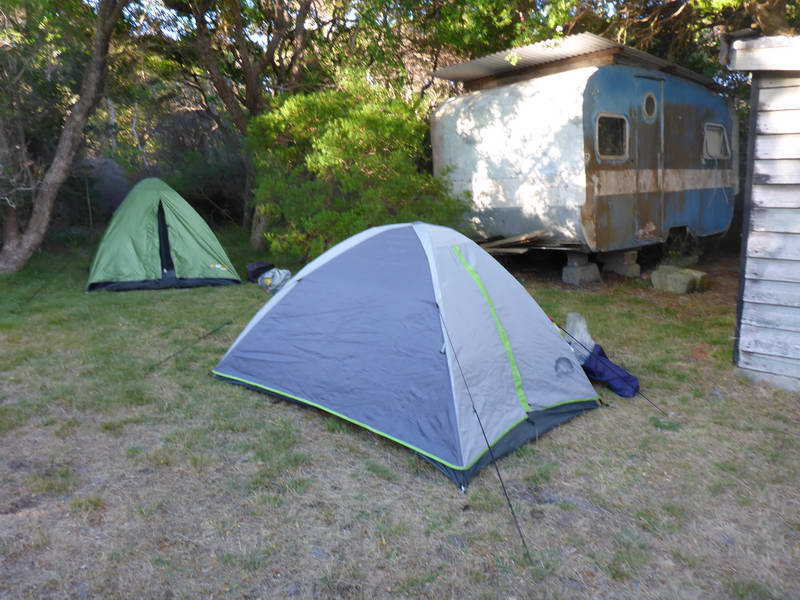
Flinders Island
Trip (almost)
February 2017
Laurie Ford
(The
Old Man)
Arthur McHugh (the
retired Auditor General)
Sue Shearman (The
Girl)
John Lawler
(the
retired Man of Words)
Matt Lancaster (The
Boy)
Saturday 4th
February.
John and The Boy were the last to arrive at Little Musselroe Bay, and
though still well in advance of the scheduled 3:30pm departure time,
acknowledged the muted hrmph from The
Old Man, who had dashed up the East Coast with Arthur glued fearlessly to the passenger
seat. The Girl had taken a more leisurely drive with her beau, but as it turned
out the arrival time was inconsequential, as a stroll around the point revealed
a sea of white caps and a stiff westerly. The Old Man determined we were best
to spend the night at Little Musselroe rather than head for Swan Island, and
then look to directly cross Banks Strait tomorrow.
We wandered up the short track to find Liz Ponting. Laurie had sent
her a card some time ago, outlining our arrival date and asking if we could
leave our cars parked behind the safety of her locked gate. Liz has supported
sea kayakers in this way for many years, and it was with sadness, particularly
for Laurie and Sue who have known Liz for a considerable time, that we learned
her husband Adrian had passed away in the late months of 2016. Liz herself had
been struck by a car while crossing a street in Launceston recently and was
clearly suffering with her mobility.

We pitched tents before encountering Lyndon Anderson, lately of
Queensland, who was heading off early the next morning with two other paddlers
to try and cross Bass Strait, a crossing Laurie has made five times, the most
recent with The Girl in 2016. After previous unsuccessful attempts, this was
the fourth start for Lyndon and his first departing from the south. Clearly an
experienced sea kayaker, he was
delighted to be able to meet and talk with Laurie, though less impressed
that there were two bloody Mirage
paddlers in our group, the NSW made boats belonging to the Banks Strait
novices, Arthur and The Boy. This played well to Laurie, and they exchanged
less than complimentary anecdotes of Mirage paddlers and sea kayakers from NSW
in general, before The Boy interjected that once
we’re on the water you can kiss my rudder, Laurie Ford! To be fair, Laurie
was happy to concede that after refitting the deck lines he had paddled
Arthur’s kayak and was very happy to recommend the Mirage as a sea kayak, it
was just the people who paddled them he took issue with.
Sunday 5th
February.
It was a calm morning and we waved Lyndon and his two comrades off
soon after 7 a.m. We waited until 8:45, an hour and a half before low tide, and
headed magnetic north, expecting to be carried east with the ebb tide and then
swept back with the incoming waters as we neared Clarke Island on the northern
coast of Banks Strait. The fall between high and low tide was particularly
large, about 3 metres, and possibly compounded by our modest forward speed, the
drift to the east was strong. Indeed, this was the first time that Laurie,
following a course of magnetic north from Little Musselroe, had been carried to
the east of Cygnet Island.
The winds started westerly and were gentle but sufficient for light
sailing. After we passed Little Swan Island, The Girl rafted up to Arthur for a
short period of time to increase his sail area and push them along, before the
winds swung north westerly and sails were lowered for a time. Closer to Clarke
Island the winds rallied against the incoming tide and the swell became larger
and more confused. The Old Man and The Boy raised sails again and there was
enough of a push to surf-sail towards the shore line. Our drift eastwards had
been strong however, and we approached the coast far closer to South Head than
planned, with the other three not too far behind. We were all glad to pull into
an unnamed rocky bay and climb out of the kayaks at 2 pm, after a slow but
steady five hour crossing.
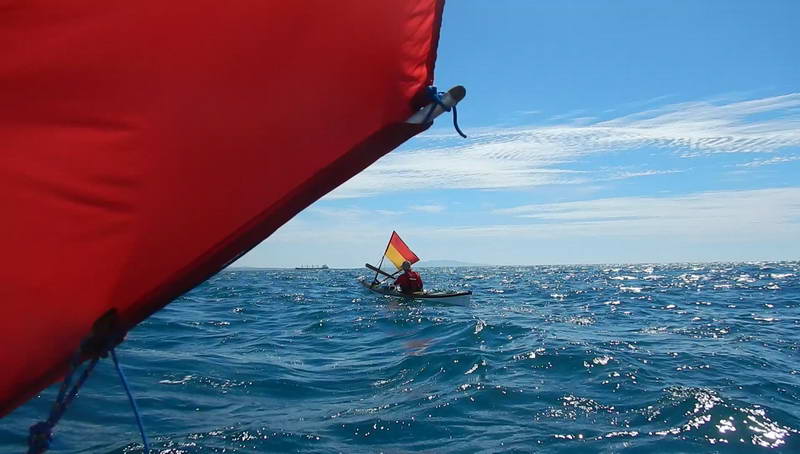
After an hour for lunch we hugged the coast towards first Rebecca Bay
and then onto Spike Bay, arriving at 5:45. The grand grey and red granite
formations along the coast from Rebecca to Spike were dramatic, and a great
introduction to the region’s geology. Ever the sage of experience and optimism,
Laurie pointed to a slight, shallow channel between rocks, and encouraging John
to paddle through, declared you could
drive a truck through there. After struggling to punt himself through, John
appeared with both grazed knuckles and marked kayak, confirming that a truck
would have been fine, as there was little water to impede its progress.
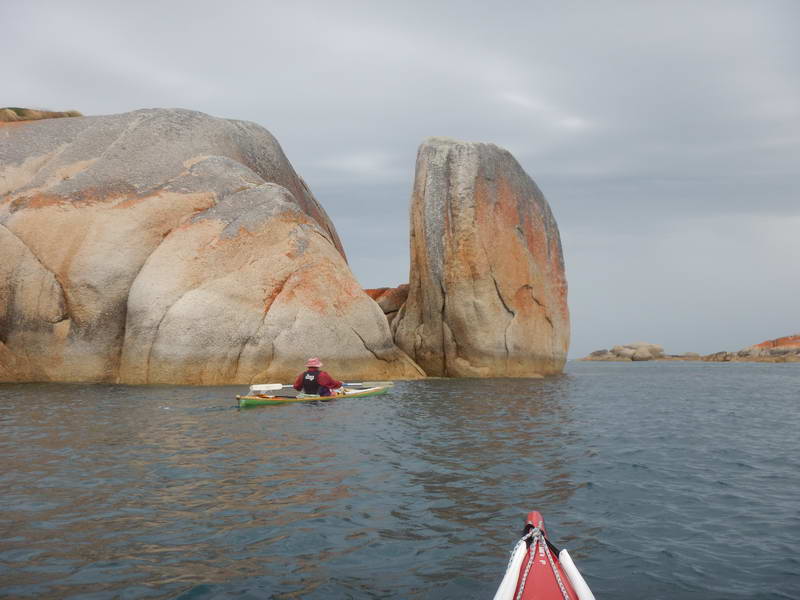
After a very long nine hour day we made camp at Spike Bay. It had begun to drizzle, but we sheltered beneath the additional tarp that The Boy had bought and with a fire soon warming us on the beach, everyone was happy to be there. The Girl tended to John’s under-arm chafing and we all ate well.
Spike Bay
Monday 6th
February 2017.
After the long previous day, the plan was to paddle the short leg
northwest to Preservation Island and rest for the remainder of the day. We took
to the water at about 10 am and with a moderate swell and good south easterly
breeze behind us raised sails immediately and rounded the corner out of Spike
Bay. The winds picked up and with or without sail we pushed on at good speed,
Matt taking some great footage on his head mounted Go-Pro, before removing it
and placing it safely in his cock-pit.
The stiffening south easterly wind began to meet the westerly swell
and quickly ebbing tide, with the seas becoming larger, lumpy and confused.
Sails down and we all started to match our forward strokes to braces as
progress slowed and Preservation Island, easily in sight, began to loom further
away. The Boy was the one to go, bracing off the back of a wave into water that
wasn’t there (or perhaps he just got it wrong!) and despite his efforts to hold
on, capsizing. John and The Girl were soon on hand to raft alongside and lend
assistance as the Boy righted his kayak, cowboyed onto the back deck and slid
back into the cockpit. The Mirage’s battery bilge had only just started to
clear the remainder of water, when The Girl noted that we needed to get moving,
as the outpouring tide was really starting to work against our passage. It
would not be the last time on this voyage that Sue’s experience and composure
would come to the fore. The shame of this incident was that the action was not
caught on Matt’s Go-Pro. The greater shame still was that the Go-Pro washed out
from the cockpit, not to be seen again. Lesson learned.
Finally, after a brief but challenging leg, Preservation Island was
there to offer shelter from the peaky swell, and with a steady 15-20 knot wind
still behind us, we sailed across the calm waters to the east of the island
towards the beach near the island’s sole building for an 11:30am landing, a job
well done. Everyone was happy to have a lazy afternoon, and after The Old Man
walked to the top of the hill and downloaded the unfavourable next day’s BOM
forecast, predicting stiff north westerly head winds, we knew an enforced rest
day was looming.
Preservation Island
We enjoyed our evening meal and the conversation that went with it,
even Laurie, a man of simple tastes and pleasures, who tucked into his favoured
egg and bacon pie and extravagant four pack of iced donuts. It was noted that
the retired Auditor General had, for the third night running, prepared himself
a meal of noodles, tuna and corn, an offing of basic sustenance not to be
waivered from for the duration of his trip. Arthur’s efforts in the morning’s
trying conditions had been particularly admirable.
Tuesday 7th
February.
Far from a howling north westerly, Preservation Island’s prominent
wind sock revealed the morning’s breeze was still pushing from the south east.
Muttering about the uselessness of weather forecasts, The Old Man checked the
BOM forecast he had downloaded the previous night, and on closer inspection,
noted that the forecast date was in January, and that the download had been
unsuccessful. We had been working off an out-dated forecast. Laurie trekked
back up through the long snaky grass and onto the prominent rocky crop to get
phone reception again and downloaded the up-to-date BOM forecast, which
confirmed the south easterly 10-20 Knot wind we could feel on our faces,
increasing over the next two days to 30 Knots and swinging north easterly later
today.
Leaving in five
minutes! Laurie
announced on his return. Almost. We started to load the kayaks ready for an 11
a.m. push off, hoping to catch whatever advantage we could from the incoming
tide as we headed up the west side of Cape Barren Island before fronting the
expected north easterly conditions. The view out over the western end of
Armstrong Channel, north of Preservation Island towards Cape Barren, was full
of white caps and after the lumpy seas of the day before, cast a little
apprehension over the group. However, as soon as we turned into the channel,
sails aloft and hugging the shoreline at Laurie’s direction to avoid the
strongest of the tidal waves, we raced along, before crossing the channel to
the shelter of Key Island Bay. Clearly the Auditor General had taken stock over
night, as with his light frame seated in his sleek boat, and The Old Man’s new
and improved sail mounted on his deck, Arthur bested our small fleet, his boat
speed leaving everyone in his wake. It is this sort of behaviour that gives bloody Mirage paddlers a bad name.
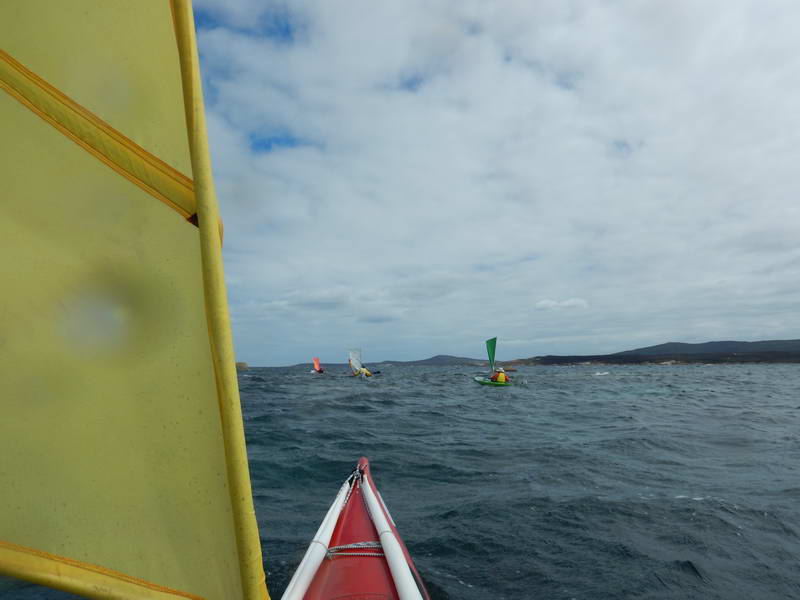
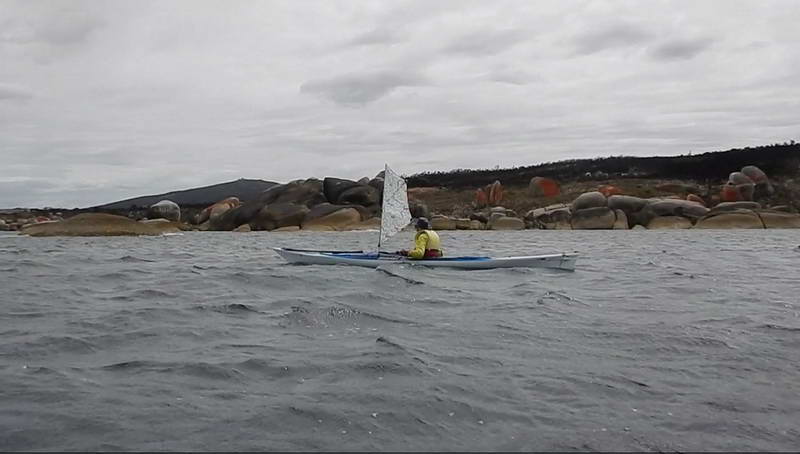
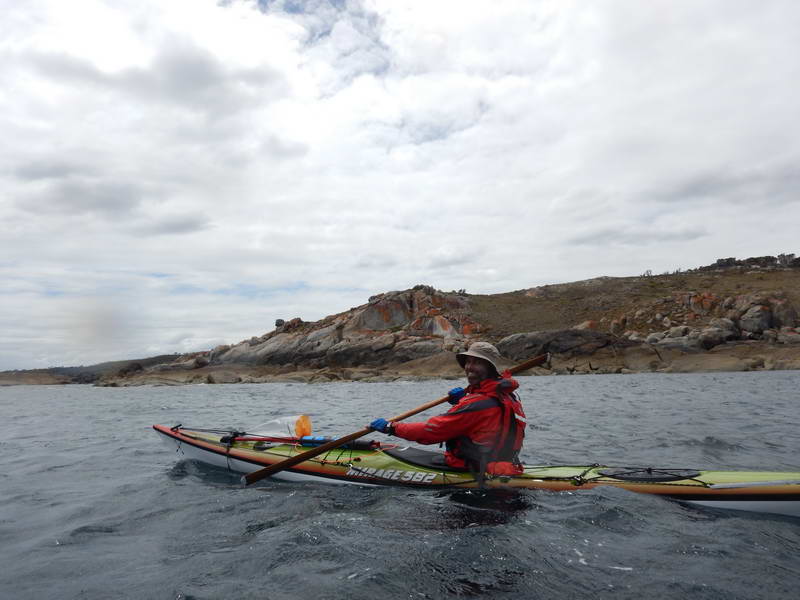
Passing inside Key Island the group sidled through the gap into
Thunder and Lightning Bay and with a good following wind Laurie encouraged us
to push across the head of the bay rather than go to shore and look for the
camp site as originally planned. At this, The Boy confirmed the worst of
stereotypes, giving the second of the Mirages its head. The swell and wind
coalesced perfectly to provide an exhilarating ride towards Cape Sir John, sail
and paddle more than keeping pace with the following waves. Rounding the Cape,
The Boy pointed into a cove to wait for the group. Together again in the lee of
Cape Barren Island, the sea was calm but the wind still sufficient for us to
sail north to Old Township Cove for a 1:45 lunch stop. Flinders Island had
entered our site, and Mt Strzelecki, separated from us by Franklin Sound,
loomed large above the intervening Long Island, as majestic a sight as many of
Tasmania’s great mainland ranges. A local man who arrived and set off with a
mask and snorkel in search of abalone called out to us, aren’t youse worried about sharks? John, the retired Man of Words,
responded wisely, there are more sharks
on land! And it was food for thought.
Old Township
Cove - Cape Barren Island
After a pleasant 45 minute break we set off again, hugging the rocky
coast in search of intermittent shelter as the prevailing winds had turned from
friend to foe and we found ourselves punching hard into a strengthening north
easterly, as predicted by the morning’s useless weather forecast. The gusts
picked up further as we crossed the extremely shallow low tide waters off Cape
Barren Township before pulling in towards the beach for shelter, our kayaks
barely clearing the weedy bed beneath us and the occasional leaping skate
thumping unexpectedly into the side of our kayaks. Light of frame and seated in
a sleek boat but with no use for The Old Man’s new and improved sail, the going
was particularly tough for the retired Auditor General, but as with each day,
his perseverance was something to behold.
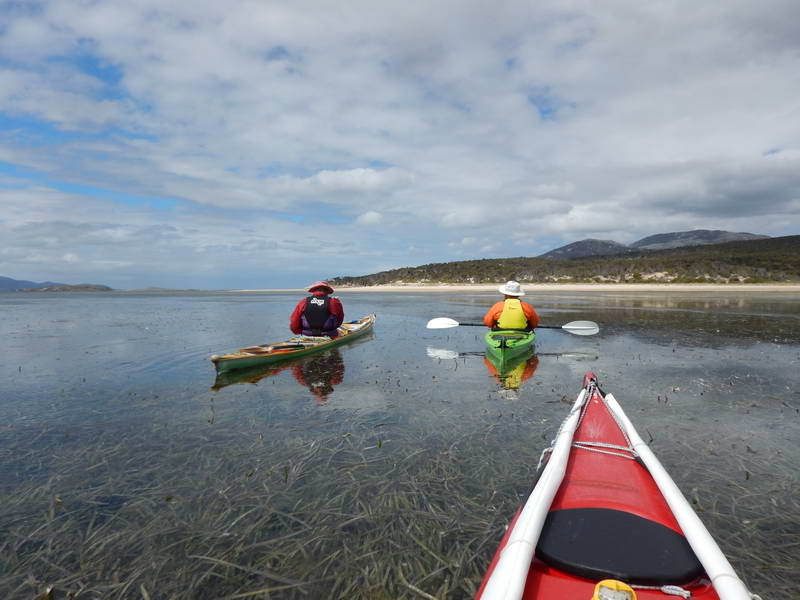
Resting on the shallow bottom
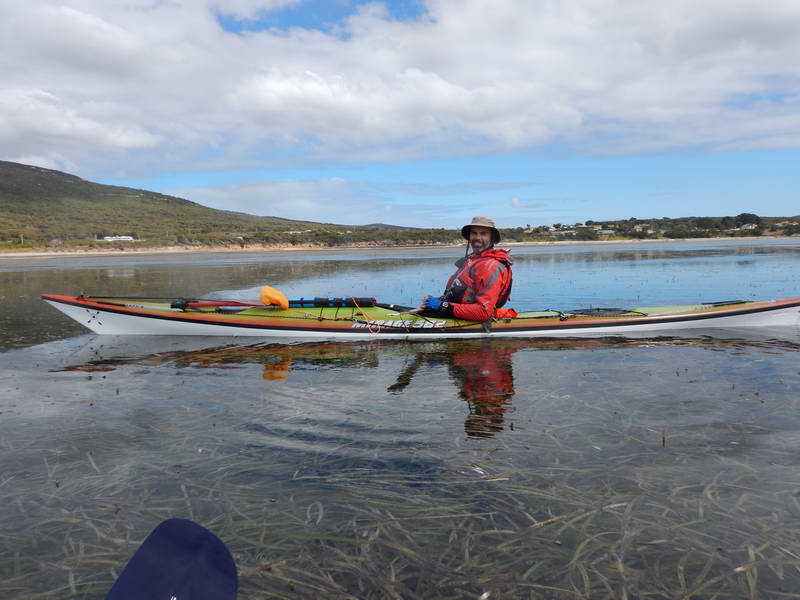
After 5 hours paddling, and with the confronting head winds continuing
to gather pace, Laurie called anchor, and we pulled onto a beautiful sandy
beach, flanked to the north east by a customary granite point and on the
township side by a clean white sand spit. We were still an hour short of our
original camping target at Ned’s Point, but Sue soon scouted a great camp spot
amongst the sheoaks, with a number of sheltered tent sites and a stone ringed
fire place, located at the end of a gravel access road. John, somewhat
prophetically, dubbed this campsite the
End of the Road. While the trip to date had been much less fearful than
John’s maiden 2014 expedition to Flinders Island, he had spent the best part of
the day wrestling his Seabird against its unstable and weather cocking habits,
and while always appearing calm and composed, he was, by self-admission,
knackered.
"End of
the Road" camp
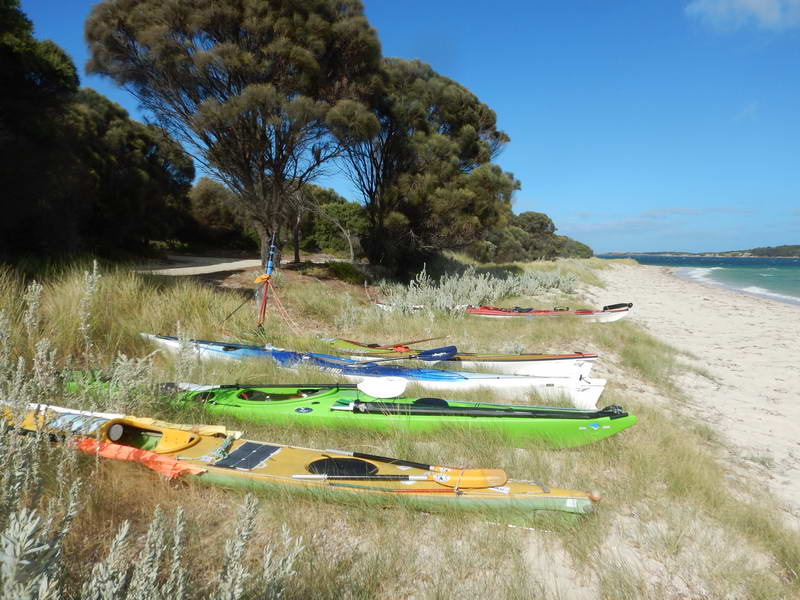
Directly across Franklin Sound, Flinders Island was tantalisingly
close and created a grand vista as the clouds blanketed its double ridge line
and the sun lowered to intervene, but the forecast was for a north easterly
gale turning northerly and we knew we may be here for a couple of nights until
the front passed. That evening around the camp fire, Arthur, the Retired
Auditor General, 75 years of age and having wrestled with leaving his beloved
Minnie at home, gave an insight into his unwavering and dogged perseverance,
reciting his father’s favourite Wordsworth verse:
Lives of great men
all remind us
We can make our
lives sublime,
And, departing,
leave behind us
Footprints on the
sands of time;
Footprints, that
perhaps another,
Sailing o’er life’s
solemn main,
A forlorn and
shipwrecked brother,
Seeing, shall take
heart again.
Let us, then be up
and doing,
With a heart for
any fate;
Still achieving,
still pursuing,
Learn to labour and
wait.
Clearly
moved, and knackered, John, the retired Man of Words, sitting in the beautiful
but fading light, could only summon the words of the great Clint Eastwood:
“Make my day.”
As
expected, we woke to a north easterly gale barring our path across Franklin
Sound to Flinders. Sue, John, Arthur and The Boy wandered along the road to the
Cape Barren Township, passing a sign indicating the real name of the camp site
we had set up at was Sandy Spit. In the small township, the locals were
welcoming and the pies in the small store piping hot. The chattiest of the
locals, clearly buoyed by the presence of a new audience, spoke to/at us about everything for some time, before
imparting on us her own life’s learning:
When we are young
we think we take the river,
but when we are
older we learn the river takes us.
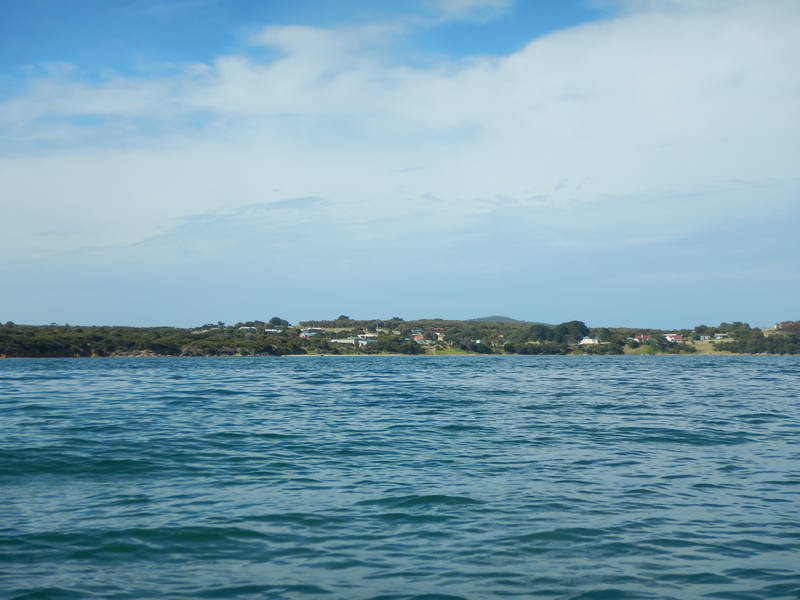
When we
returned to camp Laurie convened a team meeting. He had been looking at the
synoptic chart into the following week, and while there were a few potential
days grace between this front and the next, there was a chance that if we did
cross to Flinders we may be stranded there for a week or more. Ostensibly this
was more a concern for The Girl and The Boy who both had work to return to,
however it was not a prospect that appealed to any of the party.
The
decision was made to sit out the weather again tomorrow and then aim to return
to Preservation Island on Friday and wait for the next opportunity to cross
back over Banks Strait, possibly not until Tuesday of next week. It was
disappointing, but there was only comfortable resignation from the group to
Laurie’s decision. This camp site was indeed to be the End of the Road.
Thursday 9th February.
The Boy was
the first to rise. A brief stroll on the beach confirmed that while the wind
was northerly as predicted it had unexpectedly dropped right off and he went to
find The Old Man beneath his tent fly to pass on the good news. Leaving in 5 minutes, Laurie called out,
already aware of the change in conditions. Almost. We set off at 9:30 a.m.,
sails hoisted immediately and, other than a brief stretch pointing high into a
swinging north westerly before we turned south towards Cape Sir John again,
remaining aloft for a pleasant run all the way into Thunder and Lightning Bay
for lunch at midday.
Thunder & Lightning Bay
Sue and
Laurie showed the rest of us the camp site they had previously used, not
obvious from the beach, while The Old Man also dug out the sand around several
of the freshwater soaks entering the beach to demonstrate the availability of
good quality fresh water. Thunder and Lightning Bay lives up to its reputation
as a beautiful area, with bush running down to the back of its long sands and
the waters clear and pristine, enticing enough for Laurie and The Girl to take
a cleansing plunge before we set off again at 1 p.m.

The weather
gods continued to shine upon us this day, and we were able to sail all the way
back to Preservation Island, with the crossing back over the entrance to
Armstrong Channel particularly fun with sail up and a firm paddle taking full
advantage of the enticingly formed swell and tidal run. John had borrowed The Girl’s storm sail for the day, a lighter and
less stiff cloth than his own, and found the ongoing wrestle with his Seabird
not quite such a demand. The Girl was not inconvenienced and continued to cut a
smooth and effortless passage. Arthur was tired but continued to push on.
Likewise Laurie, who didn’t miss a beat but was ready for a rest. We rounded
the corner and eased back to the beach. Preservation Island’s hut awaited us on
a still and drizzly evening. The scurry of mice in the bedrooms soon punctured
the peace and The Girl, so strong and composed, revealed a small sign of vulnerability.
This was to be our home for the next five nights.
Friday 10th February.
We settled
in for the day, with a steady south easterly blowing outside. Laurie called the
troupes together and took the opportunity to acknowledge the retired Auditor General’s
efforts. Laurie recounted that 12 months previously he had paddled with Arthur
on the sheltered waters off Hobart’s Cornelian Bay, and as the Mona ferry
passed, had noted that Arthur had turned to point directly into the passing
ferry’s wake. Arthur didn’t possess a bracing stroke. A year later, and as a
mid-septuagenarian, Arthur had crossed Banks Strait, dealt with larger waves
and stronger winds than he had previously encountered and paddled for far
longer stretches at a time. It was indeed a truly impressive achievement, in an
environment that should never be underestimated.
Preservation Island
Later in the morning John, Arthur, Sue and Matt walked across the island to Cove Point, looking out over Rum Island. Sue found a small piece of blue crockery from the original ship wreck and handed it to Arthur as a memento
. Her eyes were equally
as sharp on the walk back, spotting a large tiger snake a metre or so off the
track. Its girth was that of a sea kayaker’s forearm and it provided a timely
reminder of the Furneaux Islands least enticing inhabitants. In all we were to
see four snakes during our stay.
The wind
all but disappeared in the evening, to the point where The Old Man briefly
considered a night paddle back to Little Musselroe before the expected 30 Knot
westerly arrived tomorrow. Less ambitious, Sue and The Boy set off at 7:30 p.m.
towards Rum Island and then continued around the south western corner to
witness a low sunset over Night Island, a seemingly granite constructed lost
city two kilometres to the west, before continuing on to circumnavigate
Preservation Island, returning as dusk fell at 8:40. These were the calmest
paddling conditions of the trip, but the wind’s gentle swing to the west was a
portent of days to come. As everyone else retired, the Old Man applied his
energy beneath torch light to modifying the only mouse trap in the building
into a deadly device.
Saturday 11th – Monday 13th
February.
Three dead
mice sat on display when we woke in the morning, The Old Man suitably proud.
Over the next four days the total would rise to 14 and the frequency of
scurrying gradually decrease. Having changed beds to a top bunk, The Girl
looked brave again. We filled in the days reading and exchanging books, playing
cards, Sudoku, taking walks and in Laurie’s case tinkering. He made repairs to
sails and kayaks and managed to wire his solar charged bilge battery to the
living room lights to provide evening light.
Wind and
meals were the two constants. The gale didn’t cease and the retired Auditor
General continued to be nourished by noodles, tuna and corn (latterly he did
add peanut butter for flavouring). The wind shifted by degree from west to
south west and back again but never let up in intensity. The wind sock flew
permanently at the horizontal and the Bass Strait seas, foaming to the west,
thundered down the channels either side of the island, as though Preservation
Island were a mere rock in a stream before blowing away down Armstrong Passage.
The BOM
observations confirmed gusts in excess of 40 knots for these days and Laurie
lamented that in thirty seven crossings of Banks Strait he had never come
across extended February weather like this or had to sit it out for so long.
However, proving wisdom is not universal, on the last night The Old Man extolled
his alternate and unifying climate change theory:
Sheep farms produce
sheep,
Cattle farms
produce cattle,
Therefore wind
farms must produce….....Wind!
Woolnorth and
Musselroe wind farms are to blame for these volatile conditions.
Tuesday 14th February.
We left the
hut clean and clear of fourteen dead mice courtesy of The Old Man’s super trap
and looked out on a calm morning.

It was hard to believe that we had gone to
bed with a gale still blowing. Based on our first day crossing, Preservation
Island to Little Musselroe as a single leg was likely to take us 6-7 hours. We
waited until about two hours before Swan Island high tide and set off on a
compass bearing of magnetic south just before 10 a.m., expecting to be carried to
the west of Cape Portland by the incoming tide and then carried back to the
Cape as the tide turned and went out. There was little wind, certainly not
enough for meaningful sailing, and the swell was a rolling 1 – 2 metres, mostly
over our right shoulder and on balance more help than hindrance. The sky was
black with hundreds of shearwaters flying low to the surface in a spectacular
display. A peaky tidal swell passed through but our progress for the first few
hours was pleasant.
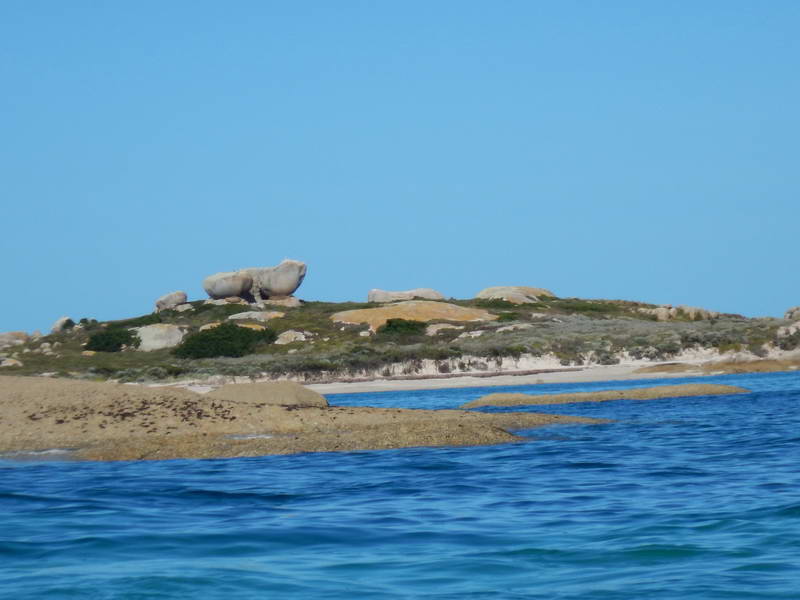
Rum Island (very few photos after this as busy towing)
We had
planned to stop together every hour, on the hour for a drink and snack. Having
checked that Laurie, Sue and Arthur were together and not far behind at about
12:45, John and The Boy paddled on ahead of the third scheduled rest. At 1
p.m., Matt turned to look for the following three and was surprised that they
had fallen quite a distance behind. As they slowly approached, it became clear
that The Girl was rafted up to Arthur, physically supporting him, and that they
were both being towed by The Old Man. Arthur had fallen sea sick and was not
able to sit upright independently in his kayak. We were three hours from
Preservation Island, a similar distance to Clark Island and, if travelling at
good speed, a probable three to four hours to Cape Portland.
Arthur
continued to vomit and not be able to tolerate fluids. The Boy hooked his tow
rope onto the front of Sue’s kayak and joined Laurie towing the two kayaks,
which were lashed together with a bow rope. Over the next hours Arthur
continued to be ill and pass between periods of dizziness and shivering. Laurie
scanned for any nearby boats on his VHF radio but did not receive a response.
Our progress was slow, probably 2-3 kilometres an hour. The effort to tow two
rafted kayaks is considerable, as the combined drag created is large. For the
paddlers, it is a physical and mental battle to keep a propulsive rhythm, with
the run of the following kayaks down a swell producing a slackening of the tow
lines before the next swell accelerates the tower forward only to be suddenly
jolted back and retarded as the tow line snaps taught. The physical demand is
also great for the person supporting, who has to lean right over the other
kayak in an awkward posture and grab the offside deck line for an extended
period of time. Laurie, Sue and Matt had practiced towing, and our kayaks had
been fitted out for purpose. Similarly, the customised deck line around
Arthur’s cockpit was there for this very reason. In hind sight, ensuring the
tow ropes were the same length would have made buddy paddling easier, and safer
for the paddler with the shorter rope, who needs to keep enough distance not to
be caught by the sudden snap of the longer tow line. But it was not the time to
quibble.
After an
hour, John replaced The Girl, rafting up and supporting Arthur, while The Girl
replaced The Old Man to continue towing alongside The Boy. Sue’s calmness and
clarity in dealing with the most acute of Arthur’s illness had carried us
through. We continued like this for a further hour, the retired Word Smith, who
was Arthur’s oldest friend in the group, keeping him engaged in conversation as
his spirits slowly began to rise. During
this time Arthur began to shiver badly and John brought this to our attention.
Arthur suffers from cold badly, almost dangerously. He has been known to be
taken off a hockey ground and put in the change rooms to warm him up during a
hockey match. Because of not paddling while being towed he was getting cold.
Laurie rafted up and opened Arthur’s rear hatch to get a double thickness polar
fleece jacket out – this immediately started to warm Arthur up again. The
unnatural paddling began to torment The Girl, who began to feel nauseous
herself. Fatuously, on many counts, the Auditor General began to perk up,
rating his wellness at eight-out-of-ten, compared to the not-so-long-ago
nothing-out-of-ten. We trialled him taking a small sip of fluid and then
sitting independently for 10 minutes, while still rafted to John, before
untying the bow line and letting him paddle unsupported. The Girl unclipped her
tow line, and to her great relief, promptly vomited, while The Boy continued to
tow Arthur towards Cape Portland.
The sea
flattened, and our speed picked up, the drag from a single kayak far less and
the Auditor General now able to assist. Save for a tidal current which ran out
to the east like a fast flowing river about 5 kilometres off the coast, the
conditions were kind to us. The Old Man and John had dropped back a little, and
aware that on previous trips the strength of the ebb tide had meant falling short
of the coast and having to divert to the safety net that was Swan Island, The
Girl dropped back to make sure they were fine. She needn’t have worried. The Old
Man had stopped paddling to talk to Tamar Sea Rescue on his VHF radio, just
to check it was working OK – not to seek help. Just before this a fishing boat had
passed behind us and also could have been contacted had we been in real trouble.
The Girl’s Spot Tracker also could have sent an SOS if needed at any time. Though
tired, we all came together just to the west of Cape Portland and headed for
the nearest beach. The Boy unclipped his tow line from the bow of Arthur’s
boat, and more than four and half hours since he first fell ill, the retired
Auditor General paddled independently onto the beach at 5:30 p.m.
After the
day’s ordeal, Laurie had a quick scan behind the dunes looking for a camp spot.
We were still an hour or so west of Little Musselroe. It was a case of slim
pickings however, and after a general discussion, Laurie agreed we would head
on, using the last of the outgoing tide to help carry us around the coast line.
Two guys in a beach buggy stopped on their way past, confirming we didn’t have
far to go. The retired Word Smith, who had once again wrestled admirably to
keep the Seabird upright was less inclined to believe them, and hearing that
Arthur was keen to continue, may have been heard to mutter it’s alright if you’ve bloody been towed half the day.
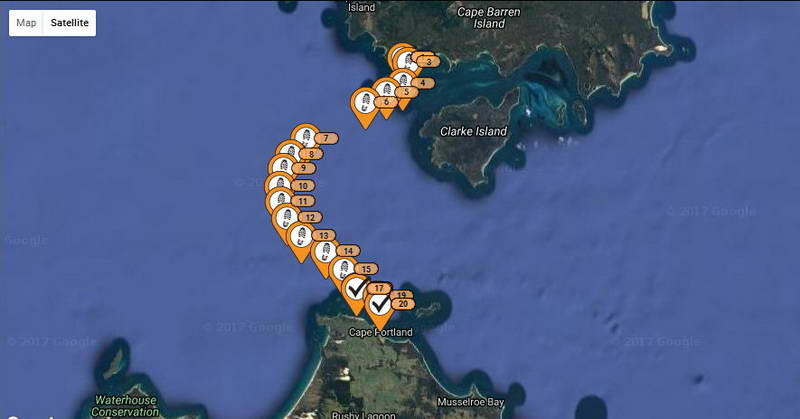
Our track across Banks Strait - tide was not ideal but the weather dictated we had to paddle this day
We set off
at 6 p.m. and headed into Little Musselroe inlet together an hour later, nine
hours after leaving Preservation Island, eight and half of that on the water.
It was a long day, but while The Girl and her beau, who had brought us all
bakery items and cider, headed to Derby, the rest of us were keen to return to
Hobart. After saying our good-byes to Liz Pointing, who was moving a little
more freely than when we last saw her, we hit the road, The Boy and the retired
Word Smith left in the dusty wake of The Old Man, with Arthur glued to his
front passenger seat.
Matt Lancaster